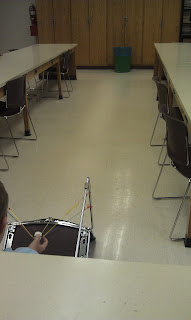Although I'm not doing this right now, I plan, in a year or two, to let my daughters grow one plant of their own. It will be their responsibility to water, feed, and weed this plant. Since they only have one plant, letting them fail is an option. The plant may die, but they'll learn something, and I still have the rest of the garden producing produce.
I have a 16' x 16' foot garden in my back yard where we grow tomatoes, green beans, zucchini, and peppers. I'm a huge fan of tomatoes and salsa, so the tomatoes and peppers are grown each year, while the remaining ground changes. This summer my daughter is old enough to understand the basics of gardening so I've been using her to help me with basic gardening. She helped plant, fertilize (organic fertilizer), water, and weed. Along the way I ask her why we do these things. Why do the plants need watered on a regular basis? What is the purpose of fertilizer? Why do we not like weeds in the garden? Teaching her about gardening introduces her to the path that food takes before it arrives on our plate.
 |
| My garden as it looked 2 weeks ago. |
 |
| Our first tomatoes of the year. |
If you've never tasted a home grown tomato, you are missing out. They are delicious and taste nothing like the bland, tasteless things they call tomatoes at the grocery store. You're kids will notice this immediately and it's the same for all vegetables. My daughter loves eating home grown tomatoes and green beans, but it's hard to get her to eat the store bought versions. This is another reason to build and grow your own garden.
If you don't have the space for a 16' x 16' garden like mine, don't worry, there are plenty of other options. As a grad student my wife and I lived in an apartment in a large city. Our apartment had a patio/deck so we grew 2 tomato plants each year in large buckets. No deck/patio? You can also grow tomato plants in your window. The plant will be smaller, but you'll still get delicious tomatoes and your kids will greatly appreciate your efforts.
Never gardened before and not sure where to start? Again, don't worry. There are plenty of web resources to get you started. I started small with two pots and two tomato plants. I learned by trial and error and slowly built a bigger garden. You don't need to be an master gardener to teach your kids how to garden. Just jump right in and you'll get better with time. Good luck!



















